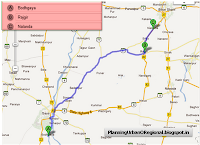Please visit my web page "Urban Tenets" at https://urbantenets.nl/
************************************************
The nature of mega infrastructure projects is such that
their impact goes beyond its physical dimensions and boundaries. The impact
goes even beyond its defined catchment, described objective, perceived
externalities, and statutory confine.
When a mega infrastructure of any kind is introduced in a
geographic system, the morphology of the immediate and distant built
environment is either going to be evolved, shaped or redefined, ecological and
bio-diversity reconfigurations may just get triggered, microclimate are going
to undergo changes, socio-economic and demographic equilibriums are bound to
change, power dynamics are bound to shift, a period of destabilisation and
adjustments are sure to be witnessed, the upheaval of opinions, emotions and
aspirations are mostly assured, the opportunity-scape are obviously to be
developed and redefined, and vested interests are bound to surface, and of
course, few consequences beyond human grasp may also surface.
Build a ring road, make an airport, build a dam, or
channelize a river, and all or most of the above phenomenon gets activated and
rarely gets acknowledged or addressed in their impact assessment in the
totality, complexity, and subtlety of it.
There are certainly positive externalities, but currently,
any (negative) impact of mega infrastructure that comes as a surprise, we tend
to label them as unintended or link them to external factors or define them as
non-linear and characteristics of wicked problems.
The possible reason for the shortsightedness of impacts and
events followed by the advent of mega infrastructure are the practical
limitations of prescriptive statutory compliance. That is understood, as one
has to stop somewhere and define the boundary of impact, contours of liability,
and exactness of liability. But it is still wise to consider and assess the
impacts beyond the statutory confine and unresolved interests, for the common
larger good.
Thankfully, today or anytime soon, most of the impacts of
mega infrastructure can be defined and visualised based on historical
observations and near-infinite scenario modelling, can be predicted, forecasted
and modelled accurately with modern tools, and can be empirically constructed,
or imagined beforehand by logic, wisdom and diverse consultation.
Author: Anoop Kumar Jha
Image: Author
************************************************
[Recent update
Starting 2024, launching urban management, interior design, home decor and commissioned artwork services in the Netherlands, serving local as well as international remote clients.
Please Note, that I am also conducting a FREE 45-minute online individual consultation on your interior design and home decor needs and aspirations if you are in the Netherlands or even internationally. Drop me an email at anoop.jha@gmail.com
Please visit my web page "Urban Tenets" at https://urbantenets.nl/
Instagram interior design page @urbantenets
Instagram fine art and illustration page @urbanoregional
************************************************
#megastructure #infrastructure #urbanmanagement
#urbanplanning #smartcities #urbandesign #landscape #ecology #economy #heritage
#tourism #municipality #Amsterdam #Utrecht #Rotterdam #Netherlands #EU #Europe
#Asia






















